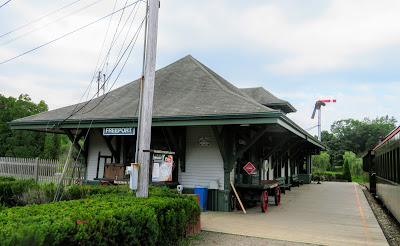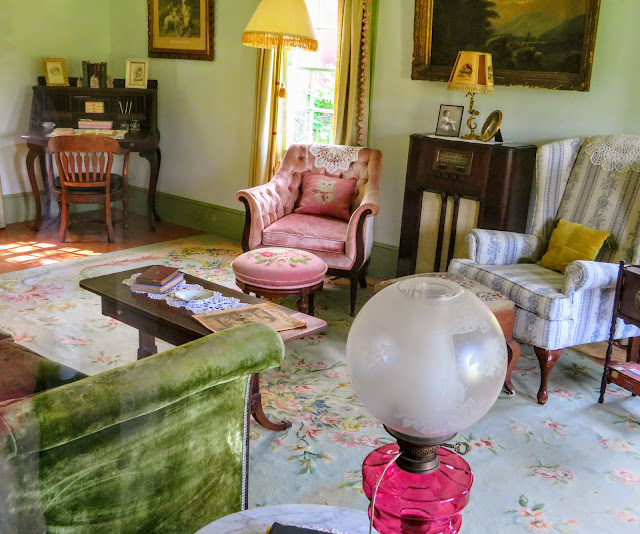Our big
event for the 8th day of our summer road trip was to take a boat
trip from Boothbay Harbor to explore in and around the coastline of Maine. It turned out that we ended up with quite a
bit of time on our hands before our cruise departed… So what to do in the
interim?
It turned
out that there was plenty to do! We
decided to pay a visit to the Boothbay Railway Village in nearby Boothbay. There was far more to see at this attraction
than I could have imagined…
This is
the first of 2 lengthy posts that I’ll be sharing with those that might be
interested. I’ll try not to be too
‘wordy’ but there are a lot of photos to share with you.
The
history of Boothbay Railway Village began in 1963 when its 27 year old founder
decided that he had to find a place to store his burgeoning collection of
railroad memorabilia. When he discovered
that a nearby railway station was up for sale, he bought it! Then he and his friends spent the summer of
1964 laying three-quarters of a mile of narrow gauge track around the site that
was to become the Railway Village.
This is
the former Freeport Maine railway station.
When it was purchased, the next feat was to cut it into 9 pieces and
move it to Boothbay, a circuitous 50 mile move for each section! Once reassembled, it became the centerpiece
for the Railway Village. It was
originally built by the Maine Central Railway Company in 1912.
The
interior of the old Freeport Maine depot has been nicely preserved. It now serves as the Boothbay Railway
Village’s visitor center and ticket office.
It’s also one of the 2 stops along the Village’s narrow gauge rail
line.
In 1964,
when the Railway Village’s founder, (a teacher), wanted to find a narrow gauge
steam locomotive, he managed to find a German-built Henschel that had been
built in 1913. Today the museum operates
3 of these Henschel 0-4-0 locomotives.
Unfortunately on the day of our visit, our train was powered by the narrow
gauge diesel locomotive pictured above...
We just
missed a train so we decided to explore part of the village before we took our
train ride…
This is
the Boothbay Town Hall. Although it’s on
the museum’s grounds, it continues to serve as a municipal building for the
town. This Greek revival structure was
built in 1847 at a cost of $700.00. ($191,000 + in 2016 dollars)
This is
the Spruce Point Chapel. It was built in
1923 by wealthy summer residents as a place of worship for their staff and
local children. It was moved to this
site in 1996.
This 1950
Huber Road Grader Model B is one of many interesting items on display in the
Farm Equipment Shed. It was donated to
the museum by Boothbay Harbor. The Huber
Manufacturing Company was founded in Marion Ohio in 1875 with all related
production ceasing in 2002.
Notes:
·
This 68
year old road grader is still in use, helping to maintain the Boothbay Railway
Village grounds.
·
Edward
Huber patented the ‘revolving hay rake’ in 1863, allowing one man to do in 3
hours what 3 men would take an entire day to complete.
This is a
McCormick-Deering Farmall F-12 tractor.
This series was built between 1932 and 1938. Just to confuse the brand name a little more,
this tractor was manufactured by International Harvester at their plant in
Chicago Illinois.
The
Oliver Chilled Plow Works began operation in 1853. By 1918 the company was building tractors. This is a 1953 Oliver Tractor Model
OC-6. It was donated to the museum by
Southport Maine. With crawler tracks and
this plow built by the Sergeant Company of Portland Maine, this vehicle has a
long and useful service life.
This
photo was taken inside Stover’s Salt and Pepper House. Its home to over 600 salt and pepper shakers
as well as a kitchen from the late 1800s.
This is
Grover’s Hardware Store. On display are
tools and household goods sold by hardware stores around the late 1890s, early
1900s. Many of the items on display were
donated by Grover’s Hardware Store in Boothbay Harbor.
Grover’s Hardware Store, founded in 1951, is
located in the building formerly occupied by Boyd’s Hardware Store…which
operated back in the late 1800s.
FYI…Many
of the displays in buildings at Boothbay Railway Village are behind
plexi-glass. While it does reduce the
number of docents or employees needed to manage this sprawling museum, it is
also hard to take photos through these protective barriers.
This is
Dingley’s Store, a typical turn of the century general store. There were lots of items on display inside
including dry goods, tin containers of various products, etc. That round object is an early
refrigerator…the type produced in the early 1900s.
The block
of ice was placed in the top compartment and the food was placed on one of the
lazy-Susan wire racks below. The ice
would last about 3 days before it had to be replaced. Water drained out from the unit’s base into a
pan positioned below it. The pan had to
be regularly emptied as the ice melted or else the kitchen floor would be
flooded… Are we spoiled or what!
This old
Seagrave Fire Engine was sitting outside of the Boothbay Volunteer Fire
Department Building. I noticed a lot of
kids having a great time climbing around on it.
Note:
·
Seagrave
Fire Apparatus LLC has been in the business of manufacturing and refurbishing Seagrave
fire equipment since 1881. It is the
oldest operating company of its type in the USA. Originally located in Detroit Michigan and
then Columbus Ohio, it is now based in Clintonville Wisconsin.
…and this
is the Boothbay Volunteer Fire Department exhibit building. It is loaded with firefighting equipment, a
great stop for those who love this type of equipment. A few examples are displayed below.
This is a
1929 McCann-Porter Hook and Ladder Fire Truck from Boothbay Harbor. From what I could determine, The McCann
Company originated in Portland Maine with the shop moving to Scarborough Maine
in 1931. The factory closed in the early
1950s. This particular fire truck was
built on a Chevrolet chassis.
This
Ladder truck was last used on October 22, 1968 at the Wiscasset Inn Fire in
Wiscasset Maine.
This is
the oldest piece of fire apparatus that I noticed in the display. This is Minnehaha #1, a hand tub pumper from
1850. The unit was pulled by hand to the
fire and then the firemen hand pumped the water from the tub onto the
fire…until they ran out of water.
This is
another McCann fire engine, this one from Augusta Maine.
This unit
is a 1927 Cosmopolitan Fire Truck. I
couldn’t locate any information about this company…
If I
remember correctly, this horse drawn United States Postal Service
sleigh was located in the expansive Agricultural Shed. It was once used in Harvard Massachusetts by
the Postal Service and American Express.
Another
large building at the Village is dedicated to a large collection of antique combustion engines as well as the Maine Narrow Gauge Railway Exhibit.
The first
engine shown above was built by the Sandwich Manufacturing Company in Sandwich
Illinois. The company was founded in
1856, at first building innovative powered corn shellers and mechanical hay
pressers, a predecessor to bailers. Ca.
1912, the company began producing Sandwich “Excess Power” gasoline and kerosene
engines.
The
second engine, a very large gas engine, was built by the Otto Gas Engine
Company in Philadelphia. An Otto engine,
ca. 1870s, was considered to be the first practical power unit among internal
combustion engines. Can you believe that
this hulking machine only produced 36 horsepower?
The last
big engine was built by the Atlas Engine Works in Indianapolis Indiana. Atlas was founded ca. 1870 and by 1878 they
had 600 employees and by 1902 they had 1,500 on the payroll. For unknown reasons, the company went out of
business in 1907.
As you
can see above, there was a whole room devoted to over 200 outboard motors! There were some really old units on
display. The last photo shows a 1918
Koban outboard…very primitive looking!
The Koban Manufacturing Company was based in Milwaukee Wisconsin. They were in operation from 1914 – 1926 when
they were bought out by Evinrude. Believe
it or not, folks actually collect these old outboard motors.
I was a
little disappointed that I didn’t see an early Montgomery Ward outboard among
the collection… Sea King outboard motors were sold by that company from 1933 to
1986. Maybe I just didn’t pick up on the
brand name as I perused the collection…
This is
the barn that’s attached New England (and European) style to the rest of the Harrington
Homestead. Both the barn and home
contain a wide variety of items on display…
Love this light 2 passenger buckboard carriage along with the Portland Cutter Sleigh in the barn. The sleigh was once used by a local doctor
to go on his winter rounds in the Boothbay region.
Then
there was this huge loom…and I thought that my mother had a big loom! but it was a lot smaller than this one.
How’d you
like to do your laundry with this washing machine! It is a great improvement over washing your
clothes on rocks in a creek or using an old fashioned wash board…
The
Syracuse Washing Machine Company had its roots with a company called Dodge and
Zuill. An enterprising salesman bought
the company in 1917 and it was reorganized as the Syracuse Washer Corporation. After added outside investment in 1919, it
was renamed the Syracuse Washing Machine Company. Under the entrepreneurial guidance of its
leadership, the company sold over $100,000,000 worth of washers! Believe it or not, these washers are
considered collectibles…
These old
cast iron stoves were classy looking weren’t they? Love that green… This one was built by the
Portland Stove Foundry Company. The
Company was founded in Bangor Maine and moved to Portland in 1877. It remained in existence until the
1980s. The company not only manufactured
ranges, they also produced stoves, sinks, hollow ware and more…
I found a
beautiful 1926 Glenwood C kitchen stove for sale on the Internet. It looks a lot like this one and they only
want $3,500.00 for it!
I
certainly remember elements contained in the living room of the Harrington
Homestead. The big radio is a good
example. We used to sit around and
listen to The Lone Ranger, The Shadow, Burns and Allen as well as Amos and
Andy. It seemed like a simpler life…
I’ll end
this post with the one room school house.
This one happens to be a replica of the original, now in Sudbury
Massachusetts. It was made famous by the
children’s nursery rhyme, “Mary Had a Little Lamb”.
I think
that the school’s pot belly stove is a real work of art. The detail of the cast
iron decorative work took the efforts of a master iron molder and caster,
that’s for sure. I can see why so many
people use these stoves as focal points in their upscale or country style room
designs…
There
will be one more post coming up about the Boothbay Railway Village, but to
break up the narrative, first I’ll publish feedback on a new Knoxville
restaurant.
Just
click on any of these photos to enlarge them…
Thanks
for stopping by and wading through all my photos!




































That village is eight up your alley and I know you enjoyed exploring it.
ReplyDelete